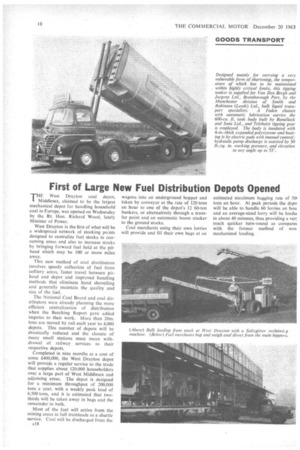First of Large New Fuel Distribution Depots Opened
Page 20

If you've noticed an error in this article please click here to report it so we can fix it.
THE West Drayton coal depot,
Middlesex, claimed to he the largest mechanical depot for handling household coal in Europe, was opened on Wednesday by the Rt. Hon. Richard Wood, lately Minister of Power.
West Drayton is the first of what will be a widespread network of stocking po:nts designed to centralize fuel stocks in consuming areas and also to increase stocks by bringing forward fuel held at the pithead Which may be 100 or more miles away.
This new method of coal distribution involves speedy collection of fuel from colliery areas, faster travel between pithead and depot and improved handling methods that eliminate hand shovelling and generally maintain the quality and size of the fuel.
The National Coal Board and coal distributors were already planning the more efficient centralization of distribution when the Beeching Report gave added impetus to their work. More than 20m. tons are moved by rail each year to 4,000 depots. This number of depots will be drastically reduced and the closure of many small stations must mean withdrawal of railway services to their respective depots.
Completed in nine months at a cost of some £400,000, the West Drayton depot will provide a regular service to the trade that supplies about 120,000 householders over a large part of West Middlesex and adjoining areas. The depot is designed for a minimum throughput of 200,000 tons a year, with a weekly peak load of 6,500 tons, and it is estimated that twothirds will be taken away in bags and the remainder in bulk.
Most of the fuel will arrive from the mining areas in full trainloads as a shuttle service. Coal will be discharged from the A18 wagons into an underground hopper and taken by conveyor at the rate of 120 tons an hour to one of the depot's 12 60-ton bunkers, or alternatively through a transfer point and an automatic boom stacker to the ground stocks.
Coal merchants using their own lorries will provide and fill their own bags at an estimated maximum bagging rate of 501 tons an hour. At peak periods the depo will be able to handle 60 lorries an hou and an average-sized lorry will be loade( in about 40 minutes, thus providing a ver: much quicker turn-round as compare( with the former method of non mechanized loading.




























































































